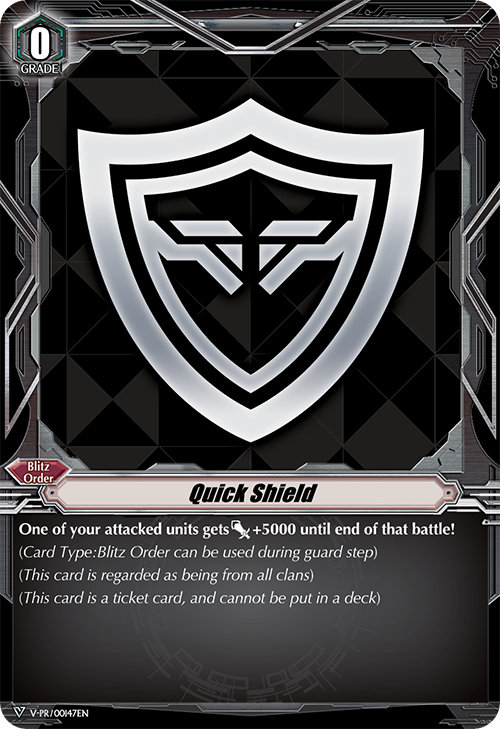
The Basics of Guarding
Cardfight!! Vanguard Fundamentals
Prologue: Introduction to Guarding
 The goal of guarding is to guard your opponent’s attacks using as little shield as possible while keeping your combo pieces in your hand. This allows you to keep your larger shield in hand for turns that matter while minimizing the amount of damage you’ll take. Alternatively, this lets you have more potent turns due to being able to save all of your core pieces in hand. This is one of the main skills that allow pro players to play the exciting games you all have experienced!
The goal of guarding is to guard your opponent’s attacks using as little shield as possible while keeping your combo pieces in your hand. This allows you to keep your larger shield in hand for turns that matter while minimizing the amount of damage you’ll take. Alternatively, this lets you have more potent turns due to being able to save all of your core pieces in hand. This is one of the main skills that allow pro players to play the exciting games you all have experienced!
While guarding well is a complex concept to grasp - especially because it's built upon your knowledge of how other decks work - there are still some basic rules that beginners could use as the final piece to step up their play. Once you get the hang of it, it can lead to more local and regional wins! I want to go through the many ways you can improve your guard efficiency and the fundamental rules you should abide by!
Part 1: Knowing What You Can Guard
 The general rule is to guard the small attacks and take the big attacks. This is what drives most players’ mindsets when guarding, so keeping this in mind is crucial going forward. Think of each damage as either a way to stop a turn (defensive triggers not allowing attacks to hit), or each damage as an infinite shield (in the sense that you don’t have to guard anything from hand). This way, you are more incentivised to take larger attacks, while also leaving room to decide if you should start taking small attacks for a defensive trigger.
The general rule is to guard the small attacks and take the big attacks. This is what drives most players’ mindsets when guarding, so keeping this in mind is crucial going forward. Think of each damage as either a way to stop a turn (defensive triggers not allowing attacks to hit), or each damage as an infinite shield (in the sense that you don’t have to guard anything from hand). This way, you are more incentivised to take larger attacks, while also leaving room to decide if you should start taking small attacks for a defensive trigger.
The number one point I would make is to always ask your opponent for their units’ powers before you start guarding. This is a habit you should develop as you continue to play the game, so that you know what you can guard with, and when you should take attacks. It doesn’t make sense to guard an attack that only needs a 10k shield, and then take an attack that only needs a 5k shield. By asking your opponent for their powers, you can determine if you need to guard or take attacks. For example, if your opponent has 7 attackers but they all took 5k guard, then I would take damage until I hit a defensive trigger. This way, I don’t drop 7 cards from my hand, therefore conserving it while shutting down my opponent’s turn. Of course, I won’t take too much damage, as that would put me in peril of other attacks; if I had gone to 4 damage without a defensive trigger, then I’d proceed to guard the attacks.
This doesn’t always work on decks that have small attacks, as sometimes those decks can generate bigger attacks after their small attacks. If you had gone to high damage before dealing with the larger attacks, then you’re going to have trouble guarding the larger swings, due to not being able to take damage. Matchup knowledge is crucial for how you guard, but there are a few considerations to take into account when facing a matchup you haven’t seen before. In these matchups, make sure to read the cards available on your opponent’s side before guarding, to make sure there aren’t any surprise skills or attacks that might throw you off guard. It’s generally safe to stockpile on perfect guards, in case you might need them, and take damage sparingly unless you need counterblast for your own skills.
TL;DR Guard the small attacks and take the big attacks. Make sure to ask for your opponent’s numbers and skills before guarding and plan out your hand accordingly.
Part 2: Committing to Guarding
 During your time interacting with more experienced players, you might have heard, “Why did you guard that attack, but take the other attack?” quite a bit. They’re essentially trying to convey the concept of guard commitment, which is the practice of guarding attacks that all take the same guard value or lower until they’re done. Let’s go back to our example of guarding an attack that needs a 10k shield, but taking an attack that needs a 5k shield. In this instance, the moment you guard an attack with a 10k shield, you’ve committed to guarding every other attack that is a 10k shield or less. Since the attacks are a 10k guard or less, then they can be shut down by a defensive trigger. Because of this, you are either going to take the first few attacks to shut off those 10k guard or less attacks, or you’re going to guard them all so that you don't waste cards in hand when you could have hit a defensive trigger. For instance, if you guarded 3 attacks that were all 10k guards, but took the 4th attack that was 10k guard and hit a defensive trigger, then you’ve effectively wasted 30k shield from your hand.
During your time interacting with more experienced players, you might have heard, “Why did you guard that attack, but take the other attack?” quite a bit. They’re essentially trying to convey the concept of guard commitment, which is the practice of guarding attacks that all take the same guard value or lower until they’re done. Let’s go back to our example of guarding an attack that needs a 10k shield, but taking an attack that needs a 5k shield. In this instance, the moment you guard an attack with a 10k shield, you’ve committed to guarding every other attack that is a 10k shield or less. Since the attacks are a 10k guard or less, then they can be shut down by a defensive trigger. Because of this, you are either going to take the first few attacks to shut off those 10k guard or less attacks, or you’re going to guard them all so that you don't waste cards in hand when you could have hit a defensive trigger. For instance, if you guarded 3 attacks that were all 10k guards, but took the 4th attack that was 10k guard and hit a defensive trigger, then you’ve effectively wasted 30k shield from your hand.
To avoid this, revisit the first part about asking your opponent for the powers of the units on board, and plan accordingly. Make sure to mentally assign cards in your hand to each attack, so that you can plan which attacks to take, and which attacks to guard. In a sense, committing to guarding certain attacks makes guarding easier, as you don’t need to plan out every single attack. Attacks that are the same guard value can be grouped together instead, as long as you have the hand for it.
Committing to guarding also helps you learn where you need to guard, and where you need to take attacks. It tells you what the other deck’s attack pattern is like, and what you can expect them to do going forward. It helps you take note of your hand before you start guarding, so that you know what you can and cannot guard. Not only is this a crucial skill to have, but also one that teaches you as you develop it.
TL;DR If you want to remember this, simply repeat, “If I guarded 10k, why don’t I guard 5k?”
Part 3: Guarding Around Triggers
 One thing that cannot be ignored is the effects that triggers have on our guard pattern, whether they be checked offensively or defensively. Offensive triggers dictate how much you guard the Vanguard, while defensive triggers dictate the guard pattern of the whole turn. Due to this, you must account for how much you’re feasibly going to be able to guard and how many attacks you’re feasibly going to be able to take. By repeating this, you get a feeling for how much you should guard for and if you should guard at all depending on the situation.
One thing that cannot be ignored is the effects that triggers have on our guard pattern, whether they be checked offensively or defensively. Offensive triggers dictate how much you guard the Vanguard, while defensive triggers dictate the guard pattern of the whole turn. Due to this, you must account for how much you’re feasibly going to be able to guard and how many attacks you’re feasibly going to be able to take. By repeating this, you get a feeling for how much you should guard for and if you should guard at all depending on the situation.
Vanguard attacks tend to be a no-guard, a 2-to-pass, or a PG. There are a small set of scenarios in which you would 1-to-pass, but they are usually when you can’t guard the rest of the attacks. Early on in the game when you have 3 or less damage, you can afford to no-guard the Vanguard swing. The only exception is if the opponent’s Vanguard is low enough to use one card for a 2-to-pass, or if their rear-guards are marginally bigger than the Vanguard. When you are at 4 damage or more, you want to consider 2-to-passing or PGing the Vanguard swing, as a well-timed crit or two can end the game. For example, if your opponent attacks with a 23k Vanguard and you guard for a 2-to-pass while on 4 damage, you can risk them checking a crit and another trigger to hit over and end the game. It’s better to PG your Vanguard’s attack when you know you can end the game on your next turn, or if you’re scared of your opponent possibly hitting OT.
Defensive triggers are a different beast. They dictate an entire turn, for both you and your opponent. Your guard pattern will generally change whether or not you do or don’t hit defensive triggers. You have to dictate if you would survive without one, and plan accordingly. The general rule here is to only bank on hitting defensive triggers if you know a large portion of your opponent’s turn is going to either be shut down by a trigger or two, or if it will make it easier to guard to save cards in hand. For example, if I know my opponent will have a lot of 20k guard attacks, I might take damage up to 4 or 5 to try to hit two defensives to shut down their turn or take damage until I get one defensive and guard the rest myself.
TL;DR Vanguard attacks should be guarded at high damage and whenever they don’t take a lot of cards to guard. You should also take defensive triggers into account when planning out your guard turn.
Part 4: Afterword
 Guarding in Vanguard isn’t as simple as it seems, with many factors to take into account while guarding. This is one of the fundamentals that separate good players from great players, so make sure to practice your guarding!
Guarding in Vanguard isn’t as simple as it seems, with many factors to take into account while guarding. This is one of the fundamentals that separate good players from great players, so make sure to practice your guarding!
I hope this was informative for you, as writing this article definitely assisted in reminding me of my own guarding fundamentals. This article was a lot of fun to unpack, and I’ll be satisfied if at least one person finds value in this. To recap: you want to plan out your guard pattern so that you don’t over-guard, or take unnecessary attacks; commit to guarding the attacks you planned out to not lose any shield value, and take into account offensive or defensive triggers to take attacks, or save cards in hand. These concepts incentivize more efficient guarding, and allow you to keep more shield value in hand alongside your combo pieces, so that you don’t have a bad turn.
To facilitate everything I’ve stated in this article, I’ve included some practice problems below for your convenience!
Part 5: Application and Practice
 I want to showcase a few examples of guarding patterns in this part, and help you identify how you should guard. Let’s start with the first one! For simplicity, I am going to assume that your vanguard is at 13k power.
I want to showcase a few examples of guarding patterns in this part, and help you identify how you should guard. Let’s start with the first one! For simplicity, I am going to assume that your vanguard is at 13k power.
Scenario 1
Setup: Your Vanguard is 13k. No damage is introduced in this scenario. Guard as if you are at 0 damage.
Opponent’s attack sequence: 13k, 13k, 13k, 13k
Your hand (in shield value): 5k, 5k, PG, G3
How would you guard?
A. Take the first two attacks for a defensive trigger, then guard the rest if you did not hit a defensive trigger.
B. Guard the first 3 attacks then take the last attack.
C. Take the first attack for a defensive trigger, then guard the rest if you did not hit a defensive trigger.
D. Take the first three attacks for a defensive trigger, then guard the last attack if you did not hit a defensive trigger.
Click/Hover below for the answer:
A, because you can save the PG and G3 if you do so. If you hit the defensive trigger, you can save all of the cards in your hand. If you take the first 3 attacks, you’re putting yourself at unnecessarily high damage when you could have guarded.
Scenario 2
Setup: Your Vanguard is 13k. No damage is introduced in this scenario. Guard as if you are at 0 damage.
Opponent’s attack sequence: 13k, 23k, 43k, 13k
Your hand (in shield value): 5k, 15k, 15k, 15k
How would you guard?
A. Guard the first one with a 5k, guard the second one with a 15k, take the 43k attack, then guard the last 13k attack if you did not hit a defensive trigger.
B. Guard the first one with a 5k, take the 23k attack and the 43k attack, then guard the last 13k attack if you did not hit a defensive trigger.
C. Take the first three attacks for a defensive trigger, then guard the last 13k attack if you did not hit a defensive trigger.
D. Take the first attack and hit a defensive trigger, guard 5k for the 23k attack, and take the 43k attack.
Click/Hover below for the answer:
A, B, & D are all valid answers for this scenario. A is more logically sound as you effectively use your available shield besides for the last 13k attack if you didn’t hit a trigger. B is if you are not confident that you will hit the defensive trigger on the first attack but you want to conserve hand. D is the least logically sound but saves you the most hand with the tradeoff of taking an extra damage.
Scenario 3
Setup: In this scenario, assume that your Vanguard is 13k and your opponent will hit 1 critical trigger on their Vanguard swing. You are at 4 damage, so you can only take one attack.
Opponent’s attack sequence: 15k, 18k, 29k, 33k (VG), 33k with critical trigger, 28k
Your hand (in shield value): 5k, 5k, 5k, 10k, 10k, 10k, 10k, 15k, 15k, 15k, 15k, 15k
Write out or visualize how you would guard, then check your answer below.:
Allocate accordingly:
15k - 5k guard
18k - 10k guard
29k - Take the attack
33k (VG) - 15k + 15k + 5k guard
33k w/ crit - 15k + 10k guard
28k - 15k + 5k guard
Ending with: 10k, 10k, 15k
Scenario 4
Setup: In this scenario, your Vanguard is at 13k and you are at 3 damage. You will hit a defensive trigger on the fifth damage, but guard as if you didn’t know. The opponent will check 2 triggers. Remember, the objective is to save as many cards in hand as you can.
Opponent’s attack sequence: 15k, 18k, 29k, 28k, 21k, 43k, 31k (VG; checking 2 triggers), 29k (49k after 2 triggers)
Your hand (in shield value): 5k, 5k, 5k, 5k, 5k, 15k, 15k, 15k, 15k, 25k, PG, G3
Write out or visualize how you would guard, then check your answer below.:
Allocate accordingly:
15k attack - 5k guard
18k attack - 5k + 5k
29k attack - take
28k attack - take (hit defensive trigger)
21k attack - (doesn’t hit)
43k attack - 25k guard
31k VG attack - PG (discard G3)
49k attack - 15k + 15k
Ending with: 5k, 5k, 15k, 15k
If you have any questions or want to point something out that I’ve incorrectly said, you can find me on Twitter or on Discord! Discord: CardDweeb#9519
